Programa
En primer lugar, estaban los almacenes de datos. Almacenaban los datos en filas y columnas porque todo lo que Internet y los ordenadores de la época eran capaces de distribuir era simple información textual. Mucho más tarde llegaron los lagos de datos, que podían almacenar casi cualquier tipo de datos que pudieras recopilar. Eran geniales para la era de las redes sociales y YouTube.
Pero ambos tenían desventajas: los almacenes de datos eran caros e inadecuados para la ciencia de datos moderna, mientras que los lagos de datos eran desordenados y a menudo se convertían en pantanos de datos. Así que las empresas empezaron a tener dos pilas tecnológicas separadas: almacenes para BI y analítica y lagos para aprendizaje automático.
Sin embargo, gestionar dos arquitecturas de datos diferentes era tan pesado que las empresas solían obtener malos resultados. Esta cuestión dio lugar a la arquitectura de la casa del lago, que es precisamente por lo que Databricks es famosa.
Databricks es una plataforma basada en la nube que permite a los usuarios obtener valor tanto de los almacenes como de los lagos en un entorno unificado. Este artículo dará una visión general de la plataforma, mostrando sus características más importantes y cómo utilizarlas.
Qué cubriremos en este tutorial de Databricks
Databricks es una plataforma tan masiva que su propia documentación podría convertirse en un libro. Así pues, el objetivo del artículo es proporcionarte una jerarquía de conceptos: explicaciones ordenadas linealmente de las funciones de Databricks que te llevarán de principiante a profesional decente de Databricks. Si eres totalmente novato, también puedes consultar nuestro curso Introducción a Databricks.
¡Empecemos!
1. ¿Qué es Databricks?
Cuando leas la palabra Databricks, debes pensar inmediatamente en ella como una plataforma, no como un framework o una biblioteca de Python. Normalmente, las plataformas ofrecen una amplia gama de funciones, y Databricks no es una excepción. Es una de las pocas plataformas que puede utilizar cualquier profesional de los datos, desde los ingenieros de datos hasta los modernos ingenieros de aprendizaje automático (o lo que la prensa llama hoy programadores de IA).
Databricks tiene los siguientes componentes básicos:
- Espacio de trabajo: Databricks proporciona un entorno centralizado en el que los equipos pueden colaborar sin problemas. El entorno es accesible a través de una interfaz web fácil de usar.
- Cuadernos: Databricks tiene una versión de los cuadernos Jupyter diseñada específicamente para la colaboración y la flexibilidad.
- Apache Spark: A Databricks le encanta Apache Spark. Es el motor que impulsa todo el procesamiento paralelo de conjuntos de datos gigantescos, lo que lo hace adecuado para el análisis de grandes datos.
- Delta Lake: Una mejora de los lagos de datos al proporcionar transacciones ACID. Delta Lakes garantiza la fiabilidad y coherencia de los datos, abordando los retos tradicionales asociados a los lagos de datos.
- Escalabilidad: La plataforma escala horizontalmente en lugar de verticalmente, lo que resulta ideal para las organizaciones que se enfrentan a una demanda de datos cada vez mayor.
Ventajas de Databricks
Estos componentes, en combinación, desbloquean una amplia gama de ventajas:
- Colaboración entre equipos: ingenieros, analistas, científicos e ingenieros de ML pueden trabajar sin problemas en la misma plataforma.
- Coherencia: con los cuadernos, los usuarios pueden pasar de una tarea a otra y de un lenguaje de programación a otro sin necesidad de cambiar de contexto.
- Flujos de trabajo eficientes: Los usuarios pueden realizar tareas como la limpieza de datos, la transformación y el aprendizaje automático de forma cohesionada
- Gestión de datos integrada: los usuarios pueden introducir datos en la plataforma desde múltiples fuentes, crear tablas y ejecutar SQL
- Colaboración en tiempo real: los cuadernos compartidos y las funciones de edición colaborativa permiten la colaboración en tiempo real. Varios miembros del equipo pueden trabajar simultáneamente en el mismo cuaderno.
Si te he convencido de la importancia de Databricks en el mundo de los datos, vamos a ponerte en marcha con la plataforma.
2. Configuración de la cuenta
Para configurar tu cuenta, ve a https://www.databricks.com/try-databricks y regístrate en la Edición Comunidad.
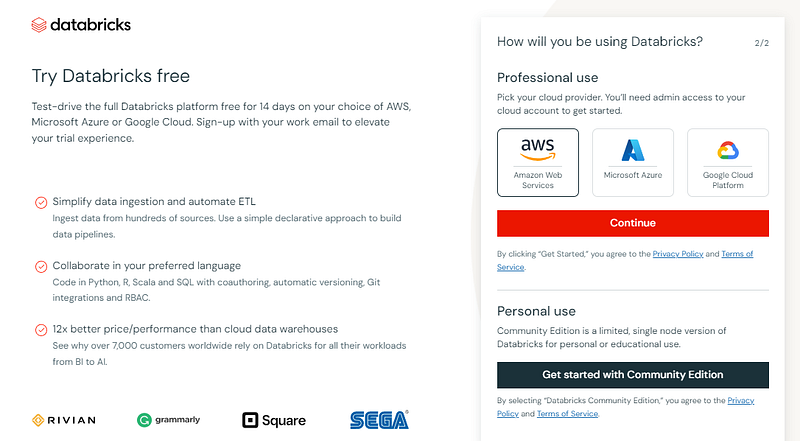
La Edición Comunidad tiene menos funciones que la versión Empresa, pero no requiere la configuración de un proveedor en la nube, lo que es estupendo para casos de uso reducido como los tutoriales.
Si tienes esta página después de la verificación por correo electrónico, puedes continuar:

3. Espacio de trabajo Databricks
La interfaz que has descubierto es el espacio de trabajo de tu dirección de correo electrónico (el espacio de trabajo de la edición comunitaria se encuentra fácilmente). En la práctica, normalmente un administrador de cuentas de tu empresa crea una única cuenta Databricks y gestiona el acceso al espacio de trabajo.
Ahora, entendamos la interfaz de usuario de la plataforma. En el panel izquierdo, tenemos el menú de los distintos componentes que ofrece Databricks. La versión para empresas tendrá aún más botones:
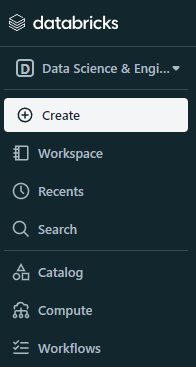
La primera opción del menú es el tipo de espacio de trabajo, que por defecto está configurado como ciencia de datos e ingeniería. Si puedes cambiarlo a aprendizaje automático, aparecerá una nueva opción de Experimentos:
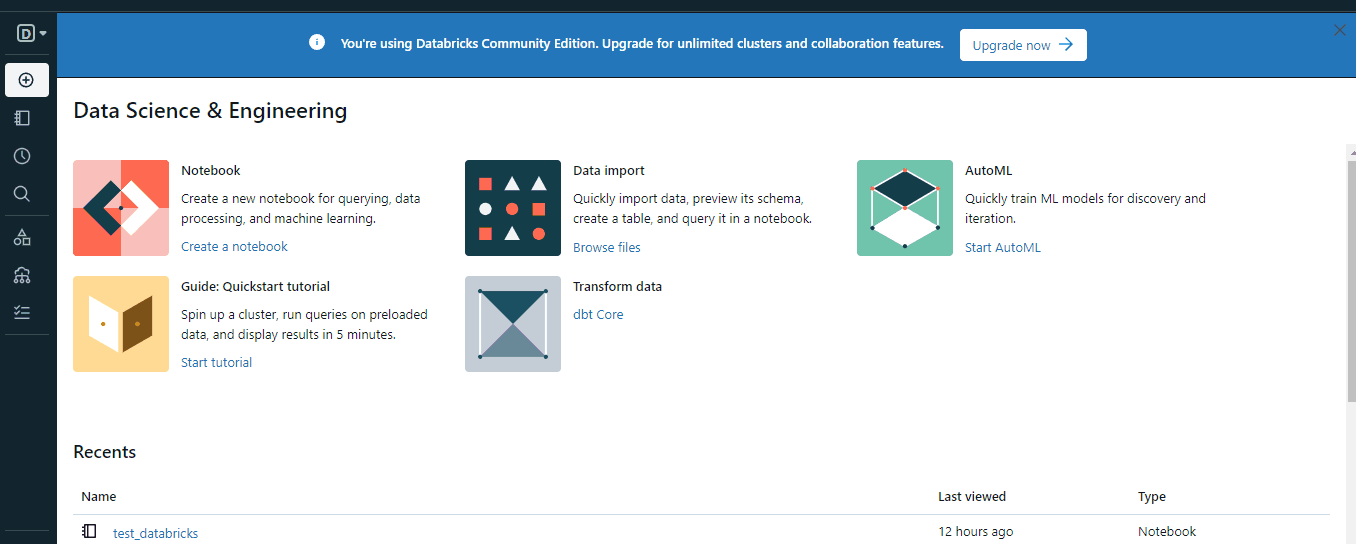
A primera vista, puede parecer que no hace gran cosa, pero una vez que actualices tu cuenta y empieces a juguetear, te darás cuenta de algunas grandes características de la plataforma:
- Hub central de recursos: cuadernos, clusters, tablas, bibliotecas y cuadros de mando
- Cuadernos en varios idiomas
- Gestión de clústeres: gestión de los recursos informáticos del espacio de trabajo para ejecutar código
- Gestión de la mesa
- Creación de cuadros de mando: Los usuarios de la BD tienen la posibilidad de reunir elementos visuales en cuadros de mando directamente en el espacio de trabajo
- Edición colaborativa en tiempo real de cuadernos
- Control de versiones para cuadernos
- Programación de trabajos (una potente función): los usuarios pueden ejecutar cuadernos y guiones a intervalos especificados
etc.
Ahora, veamos algunos de estos componentes más de cerca.
4. Clusters Databricks
Los clusters en Databricks se refieren a los recursos informáticos utilizados para ejecutar tareas de procesamiento de datos. Normalmente, los clusters son servidos por el proveedor de la nube que hayas elegido durante la configuración de la cuenta.
Los clusters de la edición comunitaria están limitados en RAM y potencia de CPU, y no incluyen GPU. Sin embargo, los usuarios premium a menudo pueden realizar las siguientes tareas con los clústeres de forma sencilla:
- Procesamiento de datos: Los clusters se utilizan para procesar y transformar grandes volúmenes de datos, utilizando los poderes de procesamiento paralelo de Spark.
- Aprendizaje automático: Puedes utilizar Python (o cualquier otro lenguaje) y sus bibliotecas para el entrenamiento y la inferencia del modelo.
- Flujos de trabajo ETL: Los clusters también admiten flujos de trabajo de Extraer, Transformar y Cargar, procesando y transformando eficazmente los datos del origen al destino.
Para crear un clúster, puedes utilizar el botón "Crear" o las opciones "Computa" del menú:
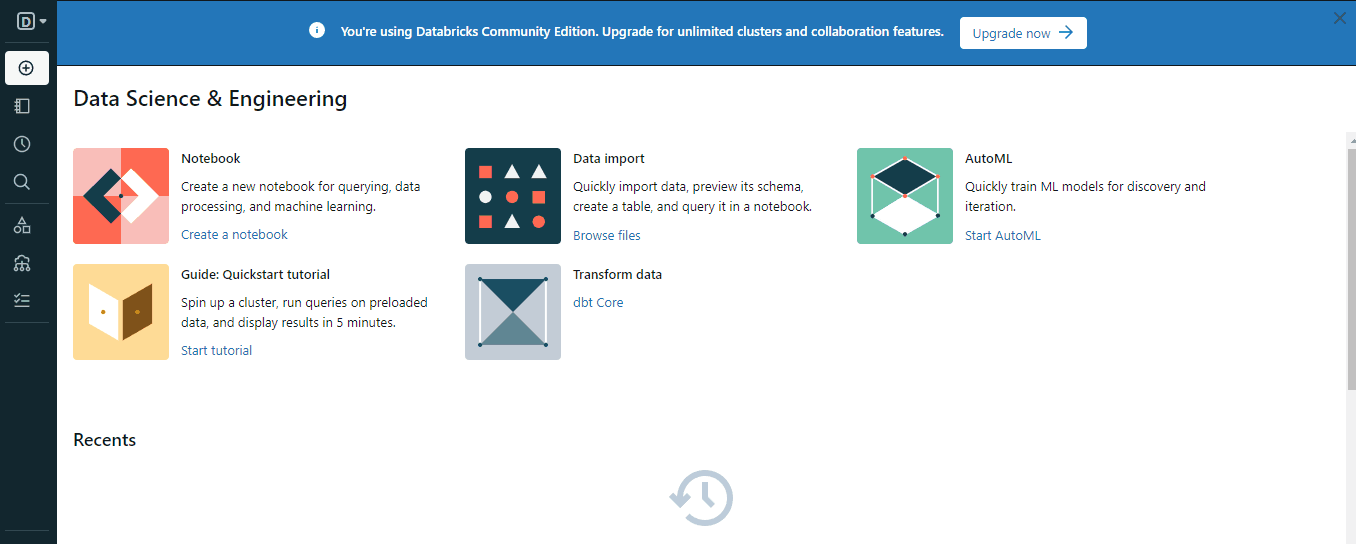
Al crear el clúster, elige una versión de Spark adecuada para tu entorno y espera unos minutos a que esté operativo.
5. Cuadernos Databricks
Una vez que tengas un clúster en funcionamiento, estarás listo para crear blocs de notas. Si has trabajado con Jupyter, Colab o DataCamp Workspaces, esto te resultará familiar:
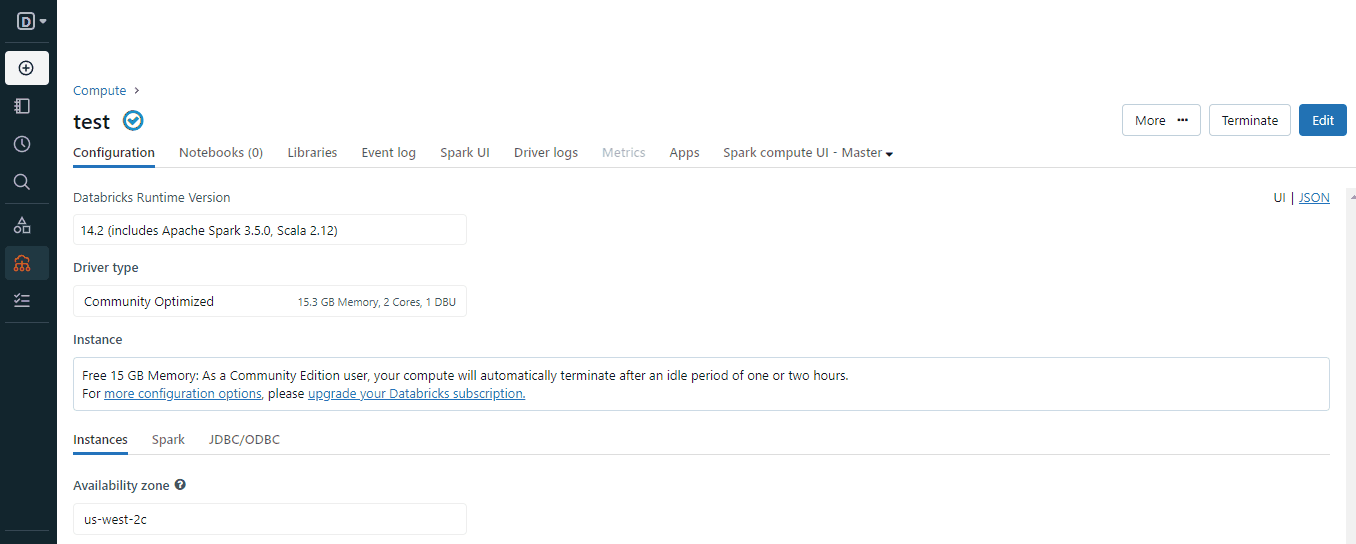
Pero en un mundo donde existe el verdadero Jupyter, ¿por qué ibas a optar por algo "similar a Jupyter"? Pues bien, los cuadernos Databricks tienen las siguientes ventajas sobre los cuadernos Jupyter:
- Colaboración: Las funciones de colaboración integradas permiten que varios usuarios trabajen en el mismo portátil al mismo tiempo. Los cambios se siguen en tiempo real.
- Entorno de ejecución: La mayoría de los proveedores de entornos Jupyter o instancias locales se basan en máquinas individuales con un hardware predefinido. Los usuarios deben instalar por su cuenta las bibliotecas y dependencias externas. En cambio, los blocs de notas Databricks funcionan con clusters, que gestionan automáticamente los recursos y el escalado según la carga de trabajo. También vienen con entornos prepoblados.
- Integración con la tecnología Big Data: Jupyter puede funcionar con Apache Spark, pero los usuarios tienen que gestionar manualmente las sesiones y dependencias de Spark. Dado que Databricks fue fundada por creadores de Spark, soporta el framework de forma nativa. Las sesiones y los clusters de Spark son gestionados automáticamente por la plataforma Databricks.
Hay muchas otras ventajas de los cuadernos Databricks sobre Jupyter, así que aquí tienes una tabla que resume las diferencias:
|
Función |
Cuadernos Jupyter |
Cuadernos Databricks |
|
Plataforma |
De código abierto, se ejecuta localmente o en plataformas en la nube |
Exclusivo de la plataforma Databricks |
|
Colaborar y compartir |
Funciones de colaboración limitadas, compartir manualmente |
Colaboración integrada, edición simultánea en tiempo real |
|
Ejecución |
Depende de servidores locales o externos |
Ejecución en clusters Databricks |
|
Integración con Big Data |
Puede integrarse con Spark, requiere configuraciones adicionales |
Integración nativa con Apache Spark, optimizada para big data |
|
Funciones incorporadas |
Herramientas/extensiones externas para el control de versiones, la colaboración y la visualización |
Integrado con funciones específicas de Databricks como Delta Lake, soporte incorporado para herramientas de colaboración y análisis |
|
Coste y ampliación |
Las instalaciones locales suelen ser gratuitas, las soluciones basadas en la nube pueden tener costes |
Servicio de pago, los costes dependen del uso, se adapta perfectamente a los clusters Databricks |
|
Facilidad de uso |
Familiar y ampliamente utilizado en la comunidad de la ciencia de datos |
Adaptado para el análisis de big data, puede tener una curva de aprendizaje más pronunciada para las funciones específicas de Databricks |
|
Visualización de datos |
Soporte integrado limitado para la visualización de datos |
Soporte integrado para la visualización de datos en el entorno del bloc de notas |
|
Gestión de clústeres |
Los usuarios tienen que gestionar manualmente las sesiones y dependencias de Spark |
La plataforma Databricks gestiona el clúster y lo escala automáticamente |
|
Casos prácticos |
Versátil para diversas tareas de ciencia de datos |
Especializado para el análisis colaborativo de big data dentro de la plataforma Databricks |
En última instancia, las ventajas anteriores de los cuadernos Databricks surten efecto en casos de uso específicos. Si quieres jugar con un conjunto de datos CSV con Pandas en tu portátil, Jupyter es mucho mejor.
Pero, para aplicaciones de nivel empresarial, Databricks como plataforma puede ser una opción mejor.
6. Ingestión de datos en Databricks
La ingesta de datos se refiere al proceso de importar datos de diversas fuentes. Databricks admite la ingesta desde diversas fuentes, como:
- AWS S3
- Almacenamiento Azure Blob
- Almacenamiento en la nube de Google
- Bases de datos relacionales (MySQL, PostgreSQL, etc.)
- Data lakes (Delta Lake, Parquet, Avro, etc.)
- Plataformas de streaming (Apache Kafka)
- Google BigQuery
- Ese archivo CSV local que tienes
etc.
Ahora vamos a ver cómo puedes cargar determinados tipos de datos en Databricks. Empezaremos con los archivos locales:
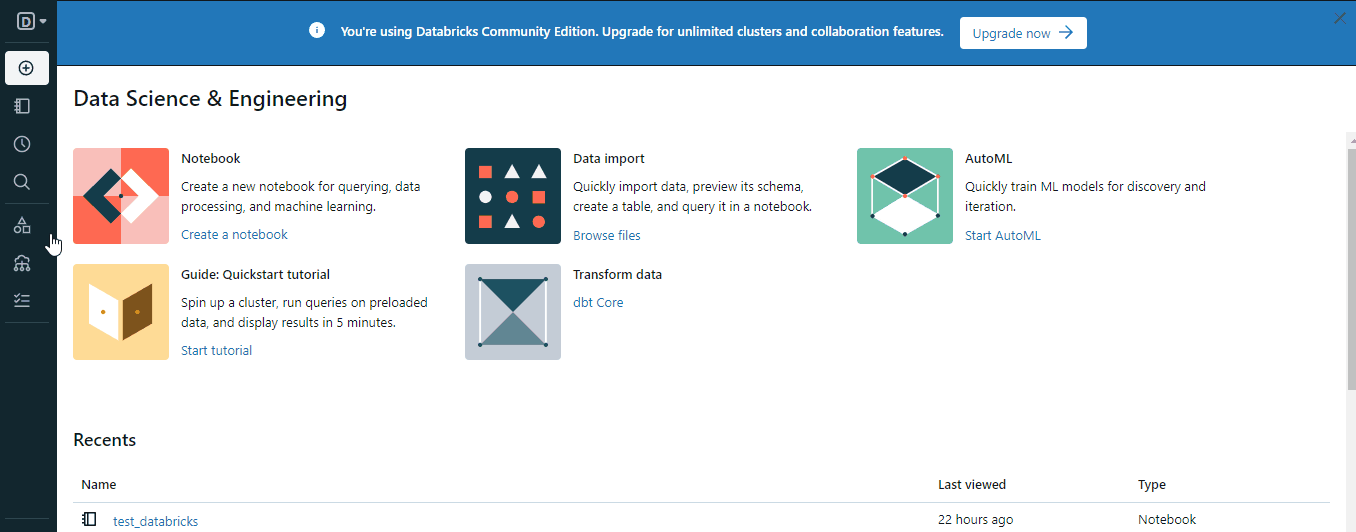
Una vez que sigas los pasos del GIF, tendrás un archivo almacenado en el espacio de trabajo. A continuación te explicamos cómo puedes cargarlo con Spark:
# Importing necessary libraries
from pyspark.sql import SparkSession
# Creating a Spark session
spark = SparkSession.builder.appName("S3ImportExample").getOrCreate()
# Defining the CSV path to the data
path = "dbfs:/FileStore/tables/diamonds.csv"
# Reading data from S3 into a DataFrame
data_from_s3 = spark.read.csv(path, header=True, inferSchema=True)
# Displaying the imported data
data_from_s3.show()
Presta atención al prefijo dbfs:. Todos los archivos del espacio de trabajo deben incluirlo para que el archivo se cargue correctamente con Spark. DBFS significa sistema de archivos databricks.
La importación de datos desde un bucket S3 es similar (para cuentas de empresa):
# Importing necessary libraries
from pyspark.sql import SparkSession
# Creating a Spark session
spark = SparkSession.builder.appName("S3ImportExample").getOrCreate()
# Defining the S3 path to the data
s3_path = "s3://your-bucket/your-data.csv"
# Reading data from S3 into a DataFrame
data_from_s3 = spark.read.csv(s3_path, header=True, inferSchema=True)
# Displaying the imported data
data_from_s3.show()
Para otros tipos de datos, puedes consultar las secciones Ingeniería de datos y Conectar con fuentes de datos de la documentación de Databricks.
7. Ejecutar SQL en Databricks
Cuando subimos el archivo diamonds.csv, se convirtió en una tabla Databricks en una base de datos llamada predeterminada:
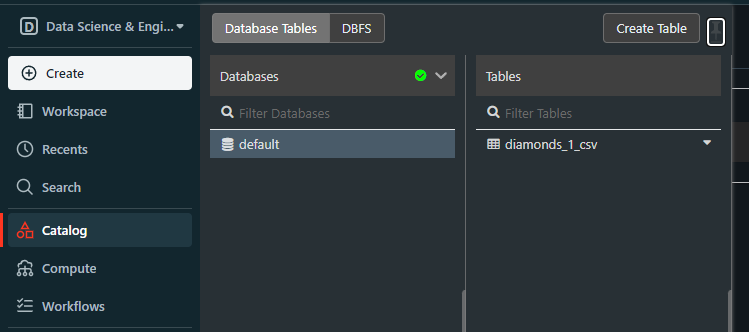
Esta base de datos default se crea siempre que intentamos cargar archivos estructurados sin crear antes la base de datos.
Si tenemos una base de datos, eso significa que podemos consultarla con SQL, no sólo con Spark. Para ello, crea una libreta nueva o cambia el idioma de la libreta actual a SQL. A continuación, prueba el siguiente fragmento de código:
SELECT * FROM default.diamonds_1_csv
LIMIT 5;
Debe devolver las cinco primeras filas de la tabla de diamantes:
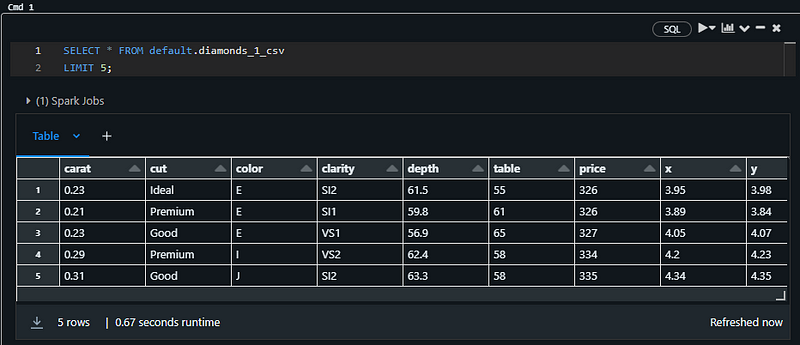
Nota: Estoy utilizando un cuaderno SQL para el fragmento anterior
También puedes cargar esta tabla en Pandas. Dentro del mismo cuaderno, pega este fragmento:
%python
# Import the necessary libraries
import pandas as pd
# Assuming 'default' is the database name and 'diamonds' is the table name
# Use the spark.sql function to query the table and retrieve the data
table_df = spark.sql("SELECT * FROM default.diamonds_1_csv")
# Convert the Spark DataFrame to a Pandas DataFrame
pandas_df = table_df.toPandas()
# Display the Pandas DataFrame
pandas_df.head()
Debe imprimir la cabecera de la tabla:
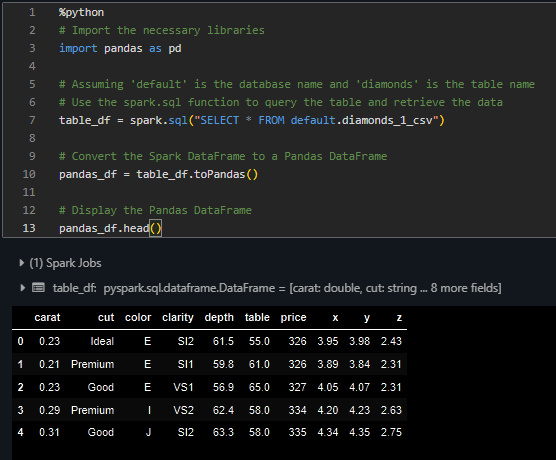
Ahora, puedes realizar cualquier tarea típica de análisis de datos en la tabla tanto con SQL como con Pandas.
Conclusión y próximos pasos
Hemos conseguido aprender y hacer muchas cosas con nuestra cuenta básica de la edición comunitaria de Databricks. Para seguir conociendo la plataforma, el primer paso es utilizar la prueba gratuita de dos semanas que Databricks ofrece para las cuentas premium.
Entonces, podrás disfrutar plenamente de las lecciones del curso Introducción a Databricks ofrecido por DataCamp. Aparte de la configuración de la cuenta, aprenderás y practicarás el uso de las siguientes funciones básicas de DataCamp:
- Administrar un espacio de trabajo Databricks
- Lectura y escritura en bases de datos externas
- Transformaciones de datos
- Orquestación de datos, es decir, programación de trabajos
- Visión general de Databricks SQL
- Utilizar Lakehouse AI para el aprendizaje automático a gran escala.

Soy un creador de contenidos de ciencia de datos con más de 2 años de experiencia y uno de los mayores seguidores en Medium. Me gusta escribir artículos detallados sobre IA y ML con un estilo un poco sarcastıc, porque hay que hacer algo para que sean un poco menos aburridos. He publicado más de 130 artículos y un curso DataCamp, y estoy preparando otro. Mi contenido ha sido visto por más de 5 millones de ojos, 20.000 de los cuales se convirtieron en seguidores tanto en Medium como en LinkedIn.